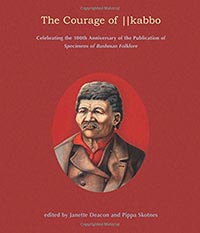The courage of ǁkabbo
 The courage of ǁkabbo
The courage of ǁkabbo
The courage of ǁkabbo: celebrating the 100th anniversary of the publication of Specimens of Bushman folklore (2014) is the ASC library’s most recent acquisition relating to the famous ǀxam and ǃkung archive of Wilhelm Bleek and Lucy Lloyd in South Africa. The book, edited by Janette Deacon and Pippa Skotnes, contains papers presented at the conference The courage of ǁkabbo, organized in Cape Town, South Africa, in 2011.
The Bleek and Lloyd archive
Including many other materials, the Bleek and Lloyd archive holds the ǀxam research notebooks by German linguist Wilhelm Bleek (1827-1875) and his sister-in-law Lucy Lloyd (1834-1914). Large parts of the archive have been made accessible through the internet at http://lloydbleekcollection.cs.uct.ac.za/, and there is: Claim to the country: the archive of Lucy Lloyd and Wilhelm Bleek, a beautifully illustrated book with CD-rom, showcasing the archive itself.
Who was ǁkabbo?
The title of the conference and its proceedings honour a man called ǁkabbo, the oldest of the speakers of the ǀxam language who stayed in the Bleek household at different times during the 1870s, and the one who made the greatest contribution to the archive. ǁkabbo had seen his people murdered by white invaders and had himself been imprisoned for stock theft from farmers claiming his ancestral lands as their own. In spite of this, coming directly from prison to the Bleek and Lloyd home, he taught them his language and told them the stories of his people for more than two years. ǁkabbo understood the grim future of his people as well as the significance of writing, and expressed the wish that his stories would be known through books. His detailed narrations covered over 5000 notebook pages. Bleek died in 1875, but Lucy Lloyd continued transcribing, translating and interpreting the stories. In 1911, she eventually got Specimens of Bushman folklore published. By then the ǀxam language was extinct.
An inspiring archive
For all the tragedy that the Bleek and Lloyd archive conveys, it is a source of inspiration for scientific research and artistic expression relating to the ǀxam, and in a broader sense to the San (or Bushman) people. The book The courage of ǁkabbo focuses in its first section on the genesis and growth of the archive and the research methods of its contributors. The second part highlights the diversity of the archive, presenting studies that made use of it in various fields: ethnography, rock art, linguistics, poetry and astronomy. The book’s last chapters report on 21st century engagements between San people and researchers.
Heleen Smits

